Ira Flatow interviewed Jesse for a live radio segment (mp3) on NPR Science Friday 17 November 2006 about the PNAS paper by Kauppi et al. on Returning Forests.
News
Modern India
A pair of articles from the same day’s newspaper about hospitality for elephants and landing an Indian on the moon show the beautiful span of contemporary India, which Jesse enjoyed again last week.
IIASA Softball (circa 1981)
Recalling the 25th anniversary of a memorable banquet of Laxenburg softball players, Judy Wagstrom sent Jesse the IIASA team photo from the 1981 party in Vienna.
Galling thrips split by mtCOI
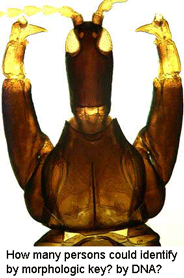 Thrips are tiny (.5 to 2 mm) plant feeding insects; approximately 4500 species are known, and some are serious agricultural pests. Kladothrips is an Australian genus of at least 35 species which form galls on Acacia trees. In Biol J Linn Soc 2006 88:555 researchers from Flinders University, Australia, apply mtDNA analysis to show that two gall morpho-types of Kladothrips rugosus represent different species.
Thrips are tiny (.5 to 2 mm) plant feeding insects; approximately 4500 species are known, and some are serious agricultural pests. Kladothrips is an Australian genus of at least 35 species which form galls on Acacia trees. In Biol J Linn Soc 2006 88:555 researchers from Flinders University, Australia, apply mtDNA analysis to show that two gall morpho-types of Kladothrips rugosus represent different species.
Originally described in 1907, K. rugosus is widely distributed across south and western Australia. Two gall types were noted, but no morphologic differences could be found in the thrips themselves. McLeish, Chapman, and Mound found pairwise uncorrected mtCOI p-distances were 0.0-0.6% within gall morphotypes, and 7.4-7.8% between, similar to distances within and among other gall thrips species. The authors aver the usual taxonomic distaste for distance measures (“Distance values are not intended as a means of identifying different species here, which is a problematic approach for species depiction, but as useful descriptors of genetic variation”). I translate this as distance measures can be used help discover new species, but are verboten in official species descriptions.
The only morphologic differences are that “abdominal segments 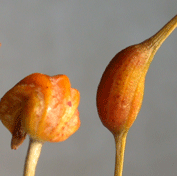 I-III are as brown as IV-VII, the metathorax is scarcely paler than the brown mesothorax and prothorax, and the sculptured reticles on the posterior half of of tergites II-III are all small and equiangular.” Phew! Not many persons could decipher such abstruse morphologic terminology, whereas DNA-based identification promises more democratic access to species identification. The main limiting factors are technological and likely solvable: establishing reference libraries and developing inexpensive DNA analytic methods.
I-III are as brown as IV-VII, the metathorax is scarcely paler than the brown mesothorax and prothorax, and the sculptured reticles on the posterior half of of tergites II-III are all small and equiangular.” Phew! Not many persons could decipher such abstruse morphologic terminology, whereas DNA-based identification promises more democratic access to species identification. The main limiting factors are technological and likely solvable: establishing reference libraries and developing inexpensive DNA analytic methods.
The authors found a third genetic cluster in K. rugosus, but were unable to discover any morphologic characters, so did not describe this as a new species. This seems scientifically inconsistent, and the authors seem to agree: “This lack of morphologic divergence has evident problems for traditional taxonomy..we suggest that “morpho-taxonomy” is little more than an historical artifact in the methodology of species recognition, despite commonly providing the most practical methods”
I hope the large data sets emerging from the barcode initiative and other genetic surveys will enable taxonomists to develop consistent methods of species delimitation, whether in thrips or thresher sharks, and the sequences themselves or their diagnostic nucleotide characters will be routinely incorporated into species descriptions.
Yantovski on Tommy Gold
Under PHE auspices, Evgeny Yantovski, one of the originators of the concept of Zero Emission Power Plants, has written a startlingly imaginative tribute to the late Tommy Gold, “Thomas Gold and the Future of Methane as a Fuel,” in which Evgeny presents Fayalite as a fuel, with methane being the energy carrier. Viewed in this way, methane is a renewable energy source.
PNAS publishes Forests paper
The PNAS has published our new paper “Returning forests analyzed with the forest identity.” We also post a press release about it from the U. of Helsinki and a map showing major countries that are gaining or losing forest. It has been a pleasure over the past year to cooperate with co-authors Pekka Kauppi, Jingyun Fang, Alexander Mather, Roger Sedjo, and Paul Waggoner.
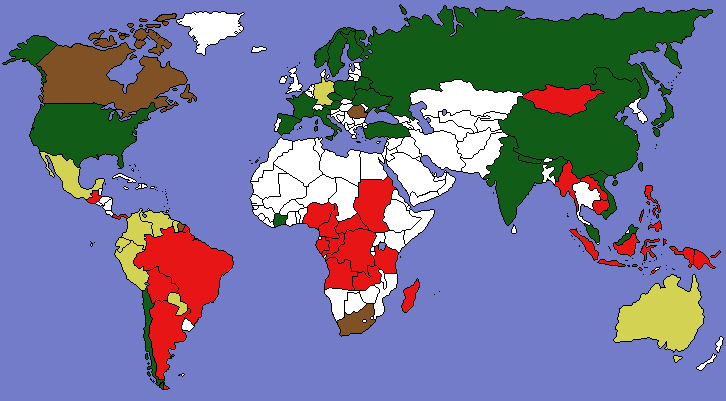
We take this occasion to recall some of our preceding papers on forests:
Foresters and DNA (PDF)
Jesse H. Ausubel, Paul E. Waggoner, and Iddo Wernick
In Williams, C.G., Landscapes, Genomics and Transgenic Forests, pp. 13-29,
Kluwer, Dordrecht, 2006.
Would editing a few bytes of the genetic message for a tree to fit human desires do harm or good? To meet demands of larger populations and changing diets, farmers have used a series of innovations to lift yields and thus reduce the area of land needed to support a person. Since 1950 rising yields have stabilized land for agriculture and now promise a Great Restoration of nature on land spared. Foresters have also lifted yields and could lift them much higher, thus sparing natural forests while meeting demand for wood products, whose growth is anyway slowing. While weak demand, numerous worries, and vague promises will slow penetration of genetically modified trees, any technology that improves spatial efficiency has appeal, and editing DNA could lift yields. Both farmers and foresters must work precisely, using fewer hectares and more bits. Fortunately, foresters have several decades in which to test and monitor their practices before genetically modified trees will diffuse widely.
On Sparing Farmland and Spreading Forest
Jesse H. Ausubel
In Clark, T. and R. Staebler, eds., Forestry at the Great Divide:
Proceedings of the Society of American Foresters 2001 Convention, Society of
American Foresters, Bethesda MD, 2002, pp. 127-138.
How Much Will Feeding More and Wealthier People Encroach on Forests?
Paul E. Waggoner and Jesse H. Ausubel
Population and Development Review 27(2):239-257 (June 2001).
David G. Victor and Jesse H. Ausubel
Foreign Affairs 79(6):127-144, November/December 2000.
The Forester’s Lever: Industrial Ecology and Wood Products
Iddo K. Wernick, Paul E. Waggoner, and Jesse H. Ausubel
Journal of Forestry 98(10):8-13, October 2000.
Searching for Leverage to Conserve Forests: The Industrial Ecology of Wood Products in the U.S.
Iddo K. Wernick, Paul E. Waggoner, and Jesse H. Ausubel
Journal of Industrial Ecology 1(3):125-145, 1997.
The forest and the creatures it shelters exemplify nature, and logging exemplifies the impacts of humans on it. By the early 1990s Americans annually removed 70% more timber from the forest than in 1900. Growing population and affluence far outpaced this rise. Since 1900 U.S. population rose more than three times and gross domestic product (GDP) per person increased almost five. Despite more people, affluence, and timber removals, the area of U.S. forests remained constant over the century. Since mid-century, standing timber volume rose nearly 30%. The practices of consumers, millers, and foresters, responding to style, ethics, technology and the consequent economics, have each contributed to these outcomes . We examine the role of each of these actors in the industrial ecology of forests to reveal their leverage for improving environmental quality. Consumers lessened their intensity of use of wood products (wood products per GDP) during the century by 2.5% annually to substantially offset the expanding population and GDP per person. Sustaining the historic trend will level or lower timber consumption if population and affluence grow at expected rates. Millers became more efficient at getting products out of logs as well as utilizing wood residues and recycled fibers for their material or energy value. Given their already high efficiencies, millers face little opportunity to reduce future harvest of trees. Foresters provide leverage by influencing the environmental impact of logging and the long-term adequacy of timber supplies. By raising productivity they promise to use less forest land to grow and harvest timber. In the future, steady or declining demand for trees coupled to greater forest productivity appear likely to spare more U.S. forest land for sequestering carbon, ecosystem services, and habitat for nature.
New data point to need for better theories about species formation
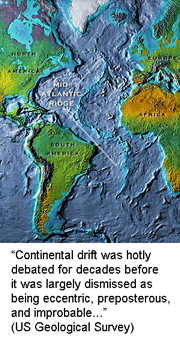 Insiders can be mistaken, in science and in other fields. At the beginning of the Human Genome Project, “the great majority of scientists dismissed the original proposal with hostility or indifference” (Great 15-year project to decipher genes stirs opposition. New York Times, June 5, 1990). The Times article details some of the initial negative reactions:
Insiders can be mistaken, in science and in other fields. At the beginning of the Human Genome Project, “the great majority of scientists dismissed the original proposal with hostility or indifference” (Great 15-year project to decipher genes stirs opposition. New York Times, June 5, 1990). The Times article details some of the initial negative reactions:
“Even if scientists manage to finish the genome project, it will have generated enormous reams of uninterpretable and often useless data”.
“The human genome project is bad science, it’s unthought-out science, it’s hyped science” said Dr. Martin Rechsteiner, a biochemist at the University of Utah. Some critics have begun aggressive letter-writing campaigns, urging colleagues who harbor similar sentiments to write Congress.
“Everybody I talk to thinks this is an incredibly bad idea,” said Dr. Michael Syvanen, a microbiologist at the Medical School of the University of California at Davis and a stout antagonist of the genome project.
Professional societies weighed in as well. A resolution adopted by the Council of the American Society for Biochemistry and Molecular Biology, and endorsed by the Federation of American Societies for Experimental Biology stated: “A large scale, massive effort to ascertain the sequence of the entire genome cannot be adequately justified at the present time… The Council wants to state in the clearest possible terms our opposition to any current proposal that envisions the establishment of one or a few large centers that are designed to map and/or sequence the human genome.” https://www.fasebj.org/cgi/reprint/1/6/502
This history comes to mind in reading the article by Hickerson, Meyer, and Moritz in October 2006 Syst Biol 55:729. According to their analysis, mathematical modelling predicts that DNA barcoding will often fail to discover young species. Their analysis is based on a classical model of speciation (Bateson-Dobzhansky-Muller) and “well-established population genetic theory”. I should tread lightly here, not being a population biologist! To my reading, these mathematical models are either unsupported or disproved by experimental evidence. The BDM model of biological species formation is “well-characterized, tractable, and its dynamics captures a range of speciation times implicit across many pre- and post-zygotic isolation models”, ie good for modelling, but is not derived from actual genetic data on differences between sister species. Genetic surveys including growing barcode libraries demonstrating limited intraspecific variation in diverse species across enormous differences in population size and generation time indicate that “well established population genetic theory” does not explain intraspecific mitochondrial diversity (Bazin et al 2006 Science 28:570).
Instead of making predictions about why barcoding will fail, I hope the same mathematic rigor will be applied to understanding why barcoding works as well as it does, why the variation within most species is low, why the distances between most species are large, and what determines the exceptions.
The fastest way forward
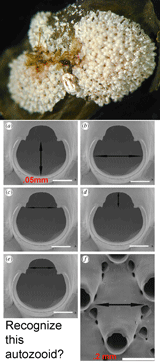 In October Proc R Soc B Gomez et al apply DNA barcoding to the cosmopolitan marine bryozoan Celleporella hyalina. Morphologic identification in this genus uses scanning electron microscopy measurements of the 0.2 mm autozooid and its 0.05 mm orifice. To eliminate potential variability associated with colonial development or environmental plasticity, these morphologic measurements are made on cloned F1 progeny grown under controlled laboratory conditions. This example highlights how standard morphologic techniques can be cumbersome and costly, and require highly-trained personnel and expensive equipment. It is unlikely this sort of morphologic identification process can be sped up, while DNA analysis is getting faster, cheaper, and more portable.
In October Proc R Soc B Gomez et al apply DNA barcoding to the cosmopolitan marine bryozoan Celleporella hyalina. Morphologic identification in this genus uses scanning electron microscopy measurements of the 0.2 mm autozooid and its 0.05 mm orifice. To eliminate potential variability associated with colonial development or environmental plasticity, these morphologic measurements are made on cloned F1 progeny grown under controlled laboratory conditions. This example highlights how standard morphologic techniques can be cumbersome and costly, and require highly-trained personnel and expensive equipment. It is unlikely this sort of morphologic identification process can be sped up, while DNA analysis is getting faster, cheaper, and more portable.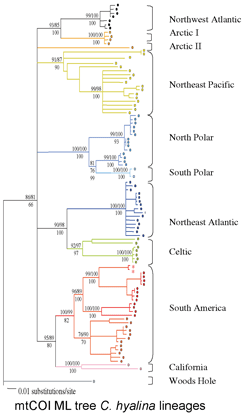
The researchers from University of Hull, University of Wales, and Universidad Catolica de la Santisima Concepcion in Chile analyzed mtCOI barcodes in 176 colonies from 33 sites around the globe, revealing at least 10 deeply divergent lineages. Mating compatability in 26 pairwise combinations showed complete reproductive isolation in 23 cases, and 3 were inconclusive due to self-fertilization. Only one of the genetically divergent, reproductively incompatible groups could be reliably separated by morphologic analysis.
It is obviously impractical to do mating studies for routine identification of bryozoans. Instead, standardized genetic analysis, ie DNA barcoding, can first help discover species (as in this case by highlighting lineages that were then subjected to other forms of biological analysis), and then be applied to assign unknown specimens to the newly revealed species. The authors conclude “DNA barcoding clearly identifies biologically meaningful groups in the C. hyalina complex” and speculate that biodiversity is similarly underestimated in other sessile marine invertebrates, including sponges and corals. “Failure to recongize cryptic speciation among sessile benthos therefore may seriously underestimate marine biodiversity as well as impeding attempts to predict the response of marine benthos to environmental change.” I conclude that DNA barcoding is the fastest way forward to help discover and then routinely identify what appear to be the vast numbers of cryptic animal species.
Sponge barcoding on the web

 The Sponge Barcoding Project https://www.spongebarcoding.org/ aims to barcode all described sponges, about 8,000 species in the phylum Porifera. The initial phase of 3 years will focus on 2,000 species covering all genera.
The Sponge Barcoding Project https://www.spongebarcoding.org/ aims to barcode all described sponges, about 8,000 species in the phylum Porifera. The initial phase of 3 years will focus on 2,000 species covering all genera.
Sponges are thought to be the earliest living branch on the multicellular animal tree and are difficult even for experts to identify. In addition to their ecological importance, sponges are sources for novel pharmaceuticals and biomaterials (eg Sipkema et al 2005 Biotech Bioengineer 90:201).
Like some corals, some sponges show very few differences in mitochondrial DNA with the standard COI barcode (corals, Shearer et al 2002 Mol Ecol 11: 2475; sponges, Erpenbeck et al 2006 Mol Ecol Notes 6: 550). The latter study suggests that the 3′ end of COI may provide greater resolution for Porifera and Cnidaria. An important goal of the initial phase of the project is to determine the best strategy for obtaining species-level identifications, one that provides sufficient resolution to separate most of the closely-related species and still takes advantage as much as possible of the benefits of standardization on 5′ COI.
I note that in animals closely related sister species are often largely or completely allopatric. In such cases, combining genetic barcode data with GIS coordinates may improve the certainty of some identifications.
For fun, I close with a sponge video:
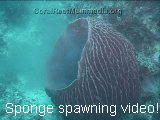
History of Marine Animal Populations
Nature Magazine quotes Jesse in a feature on the History of Marine Animal Populations of the Census of Marine Life.